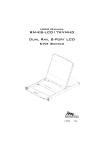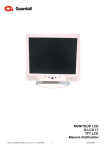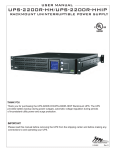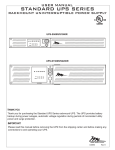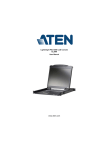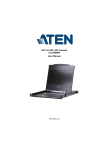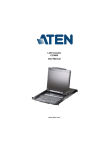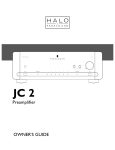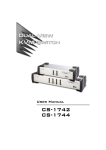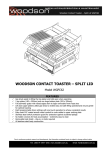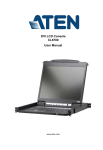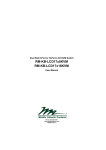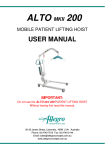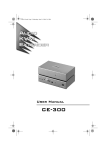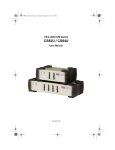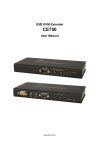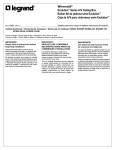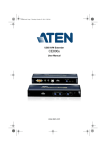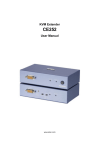Download Dual Rail LCD PS/2 - USB Console RM-KB
Transcript
Dual Rail LCD PS/2 - USB Console RM-KB-LCD 17 User Manual Phone: 973 839 1011 www.middleatlantic.com I-00386-1 Rev B RM-KB-LCD 17 User Manual FCC Information This is an FCC Class A product. In a domestic environment this product may cause radio interference in which case the user may be required to take adequate measures. This equipment has been tested and found to comply with the limits for a Class A digital device, pursuant to Part 15 of the FCC Rules. These limits are designed to provide reasonable protection against harmful interference when the equipment is operated in a commercial environment. This equipment generates, uses and can radiate radio frequency energy and, if not installed and used in accordance with the instruction manual, may cause harmful interference to radio communications. Operation of this equipment in a residential area is likely to cause harmful interference in which case the user will be required to correct the interference at his own expense. RoHS This product is RoHS compliant. ii RM-KB-LCD 17 User Manual User Notice All information, documentation, and specifications contained in this manual are subject to change without prior notification by the manufacturer. The manufacturer makes no representations or warranties, either expressed or implied, with respect to the contents hereof and specifically disclaims any warranties as to merchantability or fitness for any particular purpose. Any of the manufacturer's software described in this manual is sold or licensed `as is'. Should the programs prove defective following their purchase, the buyer (and not the manufacturer, its distributor, or its dealer), assumes the entire cost of all necessary servicing, repair and any incidental or consequential damages resulting from any defect in the software. The manufacturer of this system is not responsible for any radio and/or TV interference caused by unauthorized modifications to this device. It is the responsibility of the user to correct such interference. The manufacturer is not responsible for any damage incurred in the operation of this system if the correct operational voltage setting was not selected prior to operation. PLEASE VERIFY THAT THE VOLTAGE SETTING IS CORRECT BEFORE USE. iii RM-KB-LCD 17 User Manual Package Contents The RM-KB-LCD 17 package consists of: 1 RM-KB-LCD 17 Dual Rail LCD PS/2 - USB Console 1 Single Installation Set 1 Hybrid KVM Cable (6 feet/1.8m) 1 Power Cord 1 Firmware Upgrade Cable 1 User Manual (Soft copy in CD)* 1 Quick Start Guide (Soft copy in CD) Check to make sure that all of the components are present and in good order. If anything is missing, or was damaged in shipping, contact your dealer. Read this manual thoroughly and follow the installation and operation procedures carefully to prevent any damage to the console or to any other devices on the RM-KB-LCD 17 installation. * Changes may have been made to the manual since it was put on the CD. Please visit our web site at www.middleatlantic.com to download the most up to date version of the manual. iv RM-KB-LCD 17 User Manual Contents FCC Information . . . . . . . . . . . . . . . . . . . . . . . . . . . . . . . . . . . . . . . . . . . . . ii User Notice . . . . . . . . . . . . . . . . . . . . . . . . . . . . . . . . . . . . . . . . . . . . . . . . .iii Package Contents. . . . . . . . . . . . . . . . . . . . . . . . . . . . . . . . . . . . . . . . . . . iv About This Manual . . . . . . . . . . . . . . . . . . . . . . . . . . . . . . . . . . . . . . . . . . vii Overview . . . . . . . . . . . . . . . . . . . . . . . . . . . . . . . . . . . . . . . . . . . . . . . vii Conventions . . . . . . . . . . . . . . . . . . . . . . . . . . . . . . . . . . . . . . . . . . . .viii Chapter 1. Introduction Overview . . . . . . . . . . . . . . . . . . . . . . . . . . . . . . . . . . . . . . . . . . . . . . . . . . . 1 Features . . . . . . . . . . . . . . . . . . . . . . . . . . . . . . . . . . . . . . . . . . . . . . . . . . . 2 Requirements . . . . . . . . . . . . . . . . . . . . . . . . . . . . . . . . . . . . . . . . . . . . . . . 3 LCD Console . . . . . . . . . . . . . . . . . . . . . . . . . . . . . . . . . . . . . . . . . . . . . 3 External Console . . . . . . . . . . . . . . . . . . . . . . . . . . . . . . . . . . . . . . . . . . 3 Operating Systems . . . . . . . . . . . . . . . . . . . . . . . . . . . . . . . . . . . . . . . . 3 Components . . . . . . . . . . . . . . . . . . . . . . . . . . . . . . . . . . . . . . . . . . . . . . . . 4 Front View . . . . . . . . . . . . . . . . . . . . . . . . . . . . . . . . . . . . . . . . . . . . . . . 4 Keyboard Module . . . . . . . . . . . . . . . . . . . . . . . . . . . . . . . . . . . . . . . . . 5 LCD Module . . . . . . . . . . . . . . . . . . . . . . . . . . . . . . . . . . . . . . . . . . . . . 6 Rear View . . . . . . . . . . . . . . . . . . . . . . . . . . . . . . . . . . . . . . . . . . . . . . . 7 Chapter 2. Hardware Setup Before you Begin. . . . . . . . . . . . . . . . . . . . . . . . . . . . . . . . . . . . . . . . . . . . . 9 Rack Mounting . . . . . . . . . . . . . . . . . . . . . . . . . . . . . . . . . . . . . . . . . . . . . 10 Connecting Up . . . . . . . . . . . . . . . . . . . . . . . . . . . . . . . . . . . . . . . . . . . . . 13 Chapter 3. Operation Opening the Console . . . . . . . . . . . . . . . . . . . . . . . . . . . . . . . . . . . . . . . . 15 Opening Separately. . . . . . . . . . . . . . . . . . . . . . . . . . . . . . . . . . . . . . . 15 Opening Together . . . . . . . . . . . . . . . . . . . . . . . . . . . . . . . . . . . . . . . . 17 Operating Precautions. . . . . . . . . . . . . . . . . . . . . . . . . . . . . . . . . . . . . 18 Closing the Console . . . . . . . . . . . . . . . . . . . . . . . . . . . . . . . . . . . . . . . . . 19 Hot Plugging . . . . . . . . . . . . . . . . . . . . . . . . . . . . . . . . . . . . . . . . . . . . . . . 21 Powering Off and Restarting . . . . . . . . . . . . . . . . . . . . . . . . . . . . . . . . . . . 21 LCD OSD Configuration . . . . . . . . . . . . . . . . . . . . . . . . . . . . . . . . . . . . . . 22 The LCD Buttons . . . . . . . . . . . . . . . . . . . . . . . . . . . . . . . . . . . . . . . . . 22 LCD Adjustment Settings . . . . . . . . . . . . . . . . . . . . . . . . . . . . . . . . . . 23 Console Selection . . . . . . . . . . . . . . . . . . . . . . . . . . . . . . . . . . . . . . . . . . . 24 v RM-KB-LCD 17 User Manual Chapter 4. Firmware Upgrade The Firmware Upgrade Utility . . . . . . . . . . . . . . . . . . . . . . . . . . . . . . . . . . 25 Before You Begin . . . . . . . . . . . . . . . . . . . . . . . . . . . . . . . . . . . . . . . . 25 Firmware Upgrade Mode . . . . . . . . . . . . . . . . . . . . . . . . . . . . . . . . . . 26 Performing the Upgrade . . . . . . . . . . . . . . . . . . . . . . . . . . . . . . . . . . . 27 Upgrade Failed: . . . . . . . . . . . . . . . . . . . . . . . . . . . . . . . . . . . . . . . 29 Firmware Upgrade Recovery . . . . . . . . . . . . . . . . . . . . . . . . . . . . . . . 30 Exiting Firmware Upgrade Mode. . . . . . . . . . . . . . . . . . . . . . . . . . . . . 30 Appendix Safety Instructions . . . . . . . . . . . . . . . . . . . . . . . . . . . . . . . . . . . . . . . . . . 31 General . . . . . . . . . . . . . . . . . . . . . . . . . . . . . . . . . . . . . . . . . . . . . . . . 31 Rack Mounting . . . . . . . . . . . . . . . . . . . . . . . . . . . . . . . . . . . . . . . . . . 33 Technical Support. . . . . . . . . . . . . . . . . . . . . . . . . . . . . . . . . . . . . . . . . . . 33 Specifications . . . . . . . . . . . . . . . . . . . . . . . . . . . . . . . . . . . . . . . . . . . . . . 34 Sun Keyboard Emulation . . . . . . . . . . . . . . . . . . . . . . . . . . . . . . . . . . . . . 35 Troubleshooting . . . . . . . . . . . . . . . . . . . . . . . . . . . . . . . . . . . . . . . . . . . . 36 About SPHD Connectors . . . . . . . . . . . . . . . . . . . . . . . . . . . . . . . . . . . . . 36 vi RM-KB-LCD 17 User Manual About This Manual This User Manual is provided to help you get the most from your RM-KB-LCD 17 system. It covers all aspects of installation, configuration and operation. An overview of the information found in the manual is provided below. Overview Chapter 1, Introduction, introduces you to the RM-KB-LCD 17 KVM Console. Its purpose, features and benefits are presented, and its components are described. Chapter 2, Hardware Setup, provides step-by-step instructions for setting up your installation, and explains some basic operation procedures. Chapter 3, Operation, describes the fundamental concepts involved in operating the RM-KB-LCD 17. Chapter 4, Firmware Upgrade, explains how to upgrade the RM-KBLCD 17’s firmware with the latest available versions. An Appendix, provides specifications and other technical information regarding the RM-KB-LCD 17. vii RM-KB-LCD 17 User Manual Conventions This manual uses the following conventions: Monospaced Indicates text that you should key in. [] Indicates keys you should press. For example, [Enter] means to press the Enter key. If keys need to be chorded, they appear together in the same bracket with a plus sign between them: [Ctrl+Alt]. 1. Numbered lists represent procedures with sequential steps. ♦ Bullet lists provide information, but do not involve sequential steps. → Indicates selecting the option (on a menu or dialog box, for example), that comes next. For example, Start → Run means to open the Start menu, and then select Run. Indicates critical information. viii Chapter 1 Introduction Overview The RM-KB-LCD17 is a LCD Console module featuring an integrated 17" LCD panel, a full keyboard, and a touch pad in a 1U rack-mountable sliding housing with an AC based power input source. The RM-KB-LCD17’s LCD and keyboard/touch pad modules slide independently of each other. To maximize space in your data center, the keyboard/touch pad module slides back to hide away when not in use, while the thin profile LCD monitor rotates back – flush against the rack – allowing convenient monitoring of computer activity. For added convenience, ports for an external PS/2 or USB keyboard and mouse as well as a monitor are provided on the rear panel – permitting you to manage the switch from a local console up to 20 meters away. Since the RM-KB-LCD17's firmware is upgradable, you can stay current with the latest functionality improvements simply by downloading firmware updates from our web site as they become available. 1 RM-KB-LCD17 User Manual Features Integrated LCD Console with 17" LCD monitor in a dual rail housing with top and bottom clearance for smooth operation in a 1U high system rack Easy Installation Rack Mount Kit (single person installation) included Supports an external console with either PS/2 or USB connectors Dual interface – Supports computers and KVM switches with PS/2 or USB keyboards and mice Additional hot-pluggable USB mouse port on front panel Internal power supply High video resolution: Up to 1280 x 1024 @75Hz Supports DDC, DDC2, DDC2B DDC emulation of the LCD monitor Video settings of attached computers are automatically adjusted for optimal output to the LCD monitor Standard 105-key keyboard; Sun keyboard emulation Dual rail design allows LCD monitor and keyboard/touch pad modules to operate independently Adjustable depth to fit within the rack Firmware upgradeable Supports Microsoft Intellimouse (5 keys) Supports Logitech and Microsoft wireless mice Locking mechanism to securely lock the keyboard drawer in the open position DDC emulation – video settings of each computer are automatically adjusted for optimal output to the monitor 2 Chapter 1. Introduction Requirements LCD Console The LCD console supports most KVM switches that have PS/2 and USB console port connectors. If you are unsure whether your switch is supported or not, check with Middle Atlantic. The integrated LCD monitor's maximum resolution is 1280 x 1024 @75Hz. Make sure that none of the resolution settings of the connected computers exceed the LCD monitor's maximum resolution. External Console A VGA, SVGA, or MultiSync monitor capable of displaying the highest resolution provided by any computer in the installation USB or PS/2 keyboard and mouse Operating Systems Supported operating systems are shown in the table, below. OS Windows Linux UNIX Novell DOS Version NT and higher RedHat 7.1 and higher SuSE 9.0 and higher Mandriva (Mandrake) 9.0 and higher AIX 4.3 and higher FreeBSD 4.2 and higher Sun Solaris 8 and higher Netware 5.0 and higher 6.2 and higher 3 RM-KB-LCD17 User Manual Components Front View 1 2 3 7 4 6 5 No. 4 Component Description 1 Upper Handle Pull to slide the LCD module out; push to slide the module in. See Opening the Console, page 15, for details on sliding the console in and out. 2 LCD Module See LCD Module, page 6. 3 Keyboard Module See Keyboard Module, page 5. 4 Lower Handle Pull to slide the keyboard module out. See Opening the Console, page 15, for more details on sliding the console in and out. 5 Power LED Lights (blue) to indicate that the unit is receiving power. 6 LCD Release Catch These catches (one on each side) release the LCD module so you can slide it away. 7 Rack Mounting Tabs The rack mounting tabs located at each corner of the unit secure the chassis to a system rack. See Rack Mounting, page 10, for details. Chapter 1. Introduction Keyboard Module 1 3 2 4 5 1 6 No. Component Description 1 Keyboard Release Catch These catches (one on each side) release the keyboard module so you can slide it away. 2 Reset Button Pressing and holding this button while powering on the unit causes the RM-KB-LCD17 to revert to the original factory installed firmware version – allowing you to recover from a failed firmware upgrade. Pressing and holding this button for more than three seconds performs a system reset. Note: The button is recessed and must be pushed with a thin object - such as the end of a paper clip or a ballpoint pen. 3 Lock LEDs The Num Lock, Caps Lock, Scroll Lock LEDs are located here. 4 Keyboard Standard 105-key keyboard 5 Touch pad Standard mouse touch pad 6 External Mouse Port This USB mouse port is provided for users who prefer to use an external mouse. 5 RM-KB-LCD17 User Manual LCD Module 1 2 3 4 No. 6 Component 5 Description 1 LCD Display To access the LCD monitor, slide the LCD module out and flip up the cover. See Opening the Console, page 15, for details on sliding the LCD module out. 2 LCD Controls These buttons control the position and picture settings of the LCD display. See LCD OSD Configuration, page 22, for details. 3 LCD On/Off Button Push this button to turn the LCD monitor on and off. (The button lights when the LCD monitor is off to indicate that only the monitor is off – not the KVM switch itself.) 4 Firmware Upgrade Port The Firmware Upgrade Cable that transfers the firmware upgrade data from the administrator's computer to the RMKB-LCD17 plugs into this RJ-11 connector. 5 Firmware Upgrade Switch During normal operation and while performing a firmware upgrade, this switch should be in the NORMAL position. If a firmware upgrade operation does not complete successfully, this switch is used to perform a firmware upgrade recovery. See Firmware Upgrade Recovery, page 30, for details. Chapter 1. Introduction Rear View 1 No. 2 3 Component 4 Description 1 Power Socket This is a standard 3 prong AC power socket. The power cord from an AC source plugs in here. 2 Power Switch This is a standard rocker switch that powers the RM-KBLCD17 on and off. 3 External Console Section For flexibility and convenience, the RM-KB-LCD17 supports an independent, external, LCD Console. The external console's keyboard, monitor, and mouse cables plug in here. 4 KVM Port Section The cable linking the RM-KB-LCD17 to a computer or switch plugs in here. Note: The shape of this SPHD connector has been specifically modified so that only KVM cables designed to work with this console can plug in (see External Console, page 3 for details). Do NOT attempt to use ordinary 15 pin VGA connector cable to link this port to a computer or switch. 7 RM-KB-LCD17 User Manual This Page Intentionally Left Blank 8 Chapter 2 Hardware Setup Before you Begin 1. Important safety information regarding the placement of this device is provided on page 31. Please review it before proceeding. 2. Make sure that power to all the devices you will be connecting up has been turned off. You must unplug the power cords of any computers that have the Keyboard Power On function. 3. Packing material has been inserted to protect the RM-KBLCD17 during shipping. Slide the LCD module out (see Opening the Console, page 15), until the packing material is visible. Remove the packing material before installing the unit, as shown in the diagram below. 9 RM-KB-LCD17 User Manual Rack Mounting To rack mount the RM-KB-LCD17, do the following: 1. Attach the left and right mounting rails to the inside of the rack with the rackmount screws provided. The flange that supports the RM-KB-LCD17 will be to the inside. Rear Flange Slide Bar Front Flange Rear Attachment Sliding Bracket LEFT RAIL Support Flange RIGHT RAIL 10 Chapter 2. Hardware Setup a) Screw the front flanges to the rack first. b) Slide the bars with the rear flanges toward the rack until the flanges make contact with the rack, then screw the rear flanges to the rack. HP 10-32 thread, ¾ inch 2. Slide the RM-KB-LCD17 onto the support flanges. Use the bracket screws supplied with this package to loosely attach the front of the RM-KBLCD17 to the front of the rack (only tighten the screws part way). Phillips I head M4L6 11 RM-KB-LCD17 User Manual 3. Slide the rear attachment sliding brackets along the slide bars until they contact the rear of the RM-KB-LCD17, then use the bracket screws supplied with this package to attach the bars to the rear of the RM-KBLCD17 (tighten the screws all the way). Phillips I head M4L6 4. Slide the RM-KB-LCD17 open and closed a couple of times to be sure that it is properly aligned and operating smoothly. (See Opening the Console, page 15, for opening and closing procedures.) 5. After determining that the RM-KB-LCD17 is lined up and operating correctly, finish by fully tightening the front attached bracket screws inserted in Step 2. Note: Allow at least 2 inches (5 cm) on each side for proper ventilation, and at least 5 inches (12.5 cm) at the back for the power cord and cable clearance. 12 Chapter 2. Hardware Setup Connecting Up Refer to the example installation diagram as you perform the following steps: 1. Plug the SPHD connector end of a KVM cable (either supplied with the unit, or purchased separately, see External Console, page 3) into the LCD Console's KVM port. 2. Plug the keyboard, monitor, and mouse connectors of the KVM cable into their respective ports on a computer. 3. If you are installing an external console, plug your keyboard, monitor, and mouse into their respective ports on the Console Section of the LCD Console. The ports are color coded and marked with an icon for easy identification. 4. Plug the power cord into the AC power socket of the RM-KB-LCD17, and the other end into the AC power source. 5. Turn on the computer. 6. Turn on the power to the RM-KB-LCD17. Installation Diagram 3 4 1 6 5 2 13 RM-KB-LCD17 User Manual This Page Intentionally Left Blank 14 Chapter 3 Operation Opening the Console The RM-KB-LCD 17's console consists of two modules: an LCD display module located under the top cover; and a keyboard / touch pad module below the LCD module. The modules can either slide together, or independently. This allows you to have the LCD display available for viewing while the keyboard / touch pad module is conveniently out of the way when not in use. Opening Separately 1. Pull the top panel a few centimeters toward you. (Continues on next page.) 15 RM-KB-LCD 17 User Manual (Continued from previous page.) 2. Pull the top panel all the way out until it clicks into place. 3. Rotate the top panel all the way back to expose the LCD screen. 16 Chapter 3. Operation 4. Reach underneath and pull the keyboard module all the way out until it clicks into place. Opening Together Refer to the diagrams in the Opening Separately section as you do the following: 1. Pull the release catch and pull the top and bottom panels out until the keyboard module clicks into place. Note: Once the console has been released, you can let go of the catch. 2. Pull the top panel the rest of the way out until it clicks into place. 3. Rotate the top panel all the way back to expose the LCD screen. Note: Refer to the warning regarding placing excessive weight on the keyboard module on the following page. 17 RM-KB-LCD 17 User Manual Operating Precautions The maximum load bearing capacity of the keyboard module is 30kg. Failure to heed the information below can result in damage to the keyboard module. RIGHT Rest your hands and arms lightly on the keyboard module as you work. WRONG! DO NOT lean your body weight on the keyboard module. DO NOT place heavy objects on the keyboard module. 18 Chapter 3. Operation Closing the Console 1. Pull the release catches located on either side of the keyboard toward you to release the keyboard module, then slide the module slightly in. 2. Let go of the catches. Using the front handle, push the keyboard module all the way in. (Continues on next page.) 19 RM-KB-LCD 17 User Manual (Continued from previous page.) 3. Rotate the LCD module all the way down, then pull the rear catches to release the LCD module. 4. Using the front handle, push the module all the way in. 20 Chapter 3. Operation Hot Plugging The RM-KB-LCD 17 supports hot plugging – components can be removed and added to the console by unplugging their cables from the ports without the need to shut down the RM-KB-LCD 17. Powering Off and Restarting If it becomes necessary to Power Off the RM-KB-LCD 17 (to upgrade the firmware, for example), simply turn off the power to the unit using the rear panel power switch. Restarting the RM-KB-LCD 17 is as easy as turning the rear panel power switch back on. 21 RM-KB-LCD 17 User Manual LCD OSD Configuration The LCD Buttons The LCD OSD allows you to set up and configure the LCD display. Four buttons are used to perform the configuration, as described in the table, below: Button MENU Function When you have not entered the LCD OSD Menu function, pressing this button invokes the Menu function, and brings up the Main Menu. When you have entered the LCD OSD Menu function, and have reached a setting choice with the navigation buttons, pressing this button brings up its adjustment screen. When navigating through the menus, this button moves you Right or Up. When making an adjustment, it increases the value. When navigating through the menus, this button moves you Left or Down. When making an adjustment, it decreases the value. EXIT When you have not entered the LCD OSD Menu function, pressing this button performs an auto adjustment. An auto adjustment automatically configures all the settings for the LCD panel to what the OSD considers their optimum values to be. When you have entered the LCD OSD Menu function, pressing this button exits the current menu and returns you to the previous menu. Use it to leave an adjustment menu when you are satisfied with the adjustment you made. When you are at the Main Menu, pressing this button exits the LCD OSD. 22 Chapter 3. Operation LCD Adjustment Settings An explanation of the LCD OSD adjustment settings is given in the table below: Setting Explanation Brightness Adjusts the background black level of the screen image. Contrast Adjusts the foreground white level of the screen image. Phase If pixel jitter or horizontal line noise is visible on the display, your LCD may have the wrong phase setting. Adjust the phase setting to eliminate these problems. Clock If vertical banding is visible on the display, your LCD may have the wrong clock setting. Adjust the clock setting to eliminate vertical banding. H-Position Positions the display area on the LCD panel horizontally (moves the display area left or right). V-Position Positions the display area on the LCD panel vertically (moves the display area up or down). Color Temperature Adjusts the color quality of the display. You can adjust the warmth value, color balance, etc. The Adjust Color selection has a further submenu that lets you fine tune the RGB values. Language Selects the language that the OSD displays its menus in. OSD Duration Lets you set the amount of time the OSD displays on the screen. If there is no input for the amount of time you choose, the OSD display turns off. Reset Resets the adjustments on all menus and submenus to their factory default settings. Note: The Language setting does not return to the factory default, but remains at the one that you have set it to. 23 RM-KB-LCD 17 User Manual Console Selection Console selection on the RM-KB-LCD 17 is accomplished with hotkey combinations, as described in the following table: Combination [Ctrl] [Alt] [Shift] [P] [C] [Enter] Action to select normal mode (pc, etc.). [Ctrl] [Alt] [Shift] [S] [U] [N] [Enter] to select SUN [Ctrl] [Alt] [Shift] Activates the Firmware Upgrade Mode. [u] [p] [g] [r] [a] [d] [e] [Enter] Note: this Hotkey sequence only works when the Firmware Upgrade Recovery Switch (see page 26) is in the Normal position. [Ctrl] [Alt] [Shift] [L] [Enter] Enable Local (LCD) console; Disable Remote (external) console. [Ctrl] [Alt] [Shift] [R] [Enter] Enable Remote (external) console Disable Local (LCD) console. [Ctrl] [Alt] [Shift] [L] [R] [Enter] or Enable both consoles (default). [Ctrl] [Alt] [Shift] [R] [L] [Enter] Note: 1. Press the keys in sequence - one key at a time. First [Ctrl], then [Alt], then [Shift], etc. 2. Console selections are not saved. If the RM-KB-LCD 17 is powered off, it reverts to the default setting of both consoles enabled when it is powered on again. 3. If the KVM switch connected to the RM-KB-LCD 17 uses the [Ctrl] [Alt] [Shift] combination to invoke its hotkey mode, you won't be able to access any of its hotkey operations because the RM-KB-LCD 17 will capture the combination for console selection first. 24 Chapter 4 Firmware Upgrade The Firmware Upgrade Utility As new firmware revisions become available for the RM-KB-LCD17, firmware upgrade packages are posted on our web site. The Windows-based Firmware Upgrade Utility (FWUpgrade.exe) provides a smooth, automated process for upgrading the RM-KB-LCD17’s firmware. Check the web site regularly to find the latest firmware packages and information relating to them. Before You Begin To prepare for the firmware upgrade, do the following: 1. From a computer that is not part of your RM-KB-LCD17 installation go to our Internet support site and choose the model name that relates to your device to get a list of available Firmware Upgrade Packages. 2. Choose the Firmware Upgrade Package you want to install (usually the most recent), and download it to your computer. 3. Use the Firmware Upgrade Cable (provided with this unit), to connect a COM port on your computer to the Firmware Upgrade Port of the RMKB-LCD17. 25 RM-KB-LCD17 User Manual Firmware Upgrade Mode The RM-KB-LCD17’s firmware upgrade mode can be accessed one of two ways: by entering a hotkey sequence (see Console Selection, page 24), or by placing the RM-KB-LCD17 in firmware upgrade recovery mode (see Firmware Upgrade Recovery, page 30). Note: In order to activate the Firmware Upgrade Mode using a hotkey sequence, the Firmware Upgrade Recovery Switch (see page 6) must be set to the Normal position. 1. Turn off the power to the RM-KB-LCD17 using the power switch located on the back side of the console. 2. Slide the firmware switch to RECOVER (see page 6). 3. Turn on the power to the RM-KB-LCD17 using the power switch located on the back side of the console. When the RM-KB-LCD17 is in Firmware Upgrade Mode, the Num Lock, Caps Lock and Scroll Lock LEDs will continually flash on and off. To exit the Firmware Upgrade Mode, see Exiting Firmware Upgrade Mode, page 30. 26 Chapter 4. Firmware Upgrade Performing the Upgrade Starting the Upgrade: 1. With the RM-KB-LCD17 in Firmware Upgrade Mode, run the downloaded Firmware Upgrade Package file from your computer - either by double clicking the file icon, or by opening a command line and keying in the full path and filename. The Firmware Upgrade Utility main screen appears: The Utility inspects your installation. All the devices capable of being upgraded by the package are listed in the Device List panel. 27 RM-KB-LCD17 User Manual 2. Click Next to perform the upgrade. If you enabled Check Firmware Version, the Utility compares the device's firmware level with that of the upgrade files. If it finds that the device's version is higher than the upgrade version, it brings up a dialog box informing you of the situation and gives you the option to continue the upgrade: If you didn't enable Check Firmware Version, the Utility installs the upgrade files without checking whether they are a higher level, or not. As the Upgrade proceeds status messages appear in the Status Messages panel, and the progress toward completion is shown on the Progress bar. Upgrade Succeeded: After the upgrade has completed, a screen appears to inform you that the procedure was successful: Click Finish to close the Firmware Upgrade Utility. 28 Chapter 4. Firmware Upgrade Upgrade Failed: If the upgrade failed to complete successfully the Upgrade Failed screen appears: Click Cancel to close the Firmware Upgrade Utility. See the next section, Firmware Upgrade Recovery, for how to proceed. 29 RM-KB-LCD17 User Manual Firmware Upgrade Recovery There are basically three conditions that call for firmware upgrade recovery: When the unit’s firmware becomes corrupted for some reason and you are unable to operate it. When a firmware upgrade procedure is interrupted. When a firmware upgrade procedure fails. To perform a firmware upgrade recovery, do the following: 1. Slide the Firmware Upgrade Recovery Switch (see page 6) to the Recover position. 2. Power off and restart the RM-KB-LCD17 according to the instructions given in the Powering Off and Restarting section (see page 21). 3. Slide the Firmware Upgrade Recovery Switch back to the Normal position. 4. Repeat Step 2. Exiting Firmware Upgrade Mode To exit the Firmware Upgrade Mode, do the following: 1. Slide the Firmware Upgrade Recovery Switch (see page 6) to the Normal position. 2. Power off and restart the RM-KB-LCD17 according to the instructions given in the Powering Off and Restarting section (see page 21). 30 Appendix Safety Instructions General Read all of these instructions. Save them for future reference. Follow all warnings and instructions marked on the device. Do not place the device on any unstable surface (cart, stand, table, etc.). If the device falls, serious damage will result. Do not use the device near water. Do not place the device near, or over, radiators or heat registers. The device cabinet is provided with slots and openings to allow for adequate ventilation. To ensure reliable operation, and to protect against overheating, these openings must never be blocked or covered. The device should never be placed on a soft surface (bed, sofa, rug, etc.) as this will block its ventilation openings. Likewise, the device should not be placed in a built in enclosure unless adequate ventilation has been provided. Never spill liquid of any kind on the device. Unplug the device from the wall outlet before cleaning. Do not use liquid or aerosol cleaners. Use a damp cloth for cleaning. The device should be operated from the type of power source indicated on the marking label. If you are not sure of the type of power available, consult your dealer or local power company. The device is designed for IT power distribution systems with 230V phase-to-phase voltage. The device is equipped with a 3-wire grounding type plug. This is a safety feature. If you are unable to insert the plug into the outlet, contact your electrician to replace your obsolete outlet. Do not attempt to defeat the purpose of the grounding-type plug. Always follow your local/national wiring codes. Do not allow anything to rest on the power cord or cables. Route the power cord and cables so that they cannot be stepped on or tripped over. (Continues on next page.) 31 RM-KB-LCD17 User Manual (Continued from previous page.) If an extension cord is used with this device make sure that the total of the ampere ratings of all products used on this cord does not exceed the extension cord ampere rating. Make sure that the total of all products plugged into the wall outlet does not exceed 15 amperes. To help protect your system from sudden, transient increases and decreases in electrical power, use a surge suppressor, line conditioner, or uninterruptible power supply (UPS). Position system cables and power cables carefully; Be sure that nothing rests on any cables. Never push objects of any kind into or through cabinet slots. They may touch dangerous voltage points or short out parts resulting in a risk of fire or electrical shock. Do not attempt to service the device yourself. Refer all servicing to qualified service personnel. If the following conditions occur, unplug the device from the wall outlet and bring it to qualified service personnel for repair. The power cord or plug has become damaged or frayed. Liquid has been spilled into the device. The device has been exposed to rain or water. The device has been dropped, or the cabinet has been damaged. The device exhibits a distinct change in performance, indicating a need for service. The device does not operate normally when the operating instructions are followed. Only adjust those controls that are covered in the operating instructions. Improper adjustment of other controls may result in damage that will require extensive work by a qualified technician to repair. Do not connect the RJ-11 connector marked “UPGRADE” to a public telecommunication network. 32 Appendix Rack Mounting Before working on the rack, make sure that the stabilizers are secured to the rack, extended to the floor, and that the full weight of the rack rests on the floor. Install front and side stabilizers on a single rack or front stabilizers for joined multiple racks before working on the rack. Always load the rack from the bottom up, and load the heaviest item in the rack first. Make sure that the rack is level and stable before extending a device from the rack. Use caution when pressing the device rail release latches and sliding a device into or out of a rack; the slide rails can pinch your fingers. After a device is inserted into the rack, carefully extend the rail into a locking position, and then slide the device into the rack. Do not overload the AC supply branch circuit that provides power to the rack. The total rack load should not exceed 80 percent of the branch circuit rating. Ensure that proper airflow is provided to devices in the rack. Do not step on or stand on any device when servicing other devices in a rack. Technical Support Technical support is available both by email and online (with a browser over the web). [email protected] Phone: 973 839 1011 When you contact us, please have the following information ready beforehand: Product model number, serial number, and date of purchase. Your computer configuration, including operating system, revision level, expansion cards, and software. Any error messages displayed at the time the error occurred. The sequence of operations that led up to the error. Any other information you feel may be of help. 33 RM-KB-LCD17 User Manual Specifications Function RM-KB-LCD17 Computer Connections 1 Console Selection External Console Ports Connectors Hotkey Keyboard Video 1 x HDB-15 Female (Blue) Mouse 1 x 6-pin Mini-DIN Female (Green) 1 x USB Type A Female (Black) KVM Ports 1 x SPHD-18 Female (Yellow) External Mouse 1 x USB Type A Female (Black) FW Upgrade Switches 1 x RJ-11 Power 1 x 3-prong AC Socket Reset 1 x Semi-recessed Pushbutton Power 1 x Rocker F/W Upgrade LEDs 1 x Slide LCD Power 1 x Pushbutton LCD Adjustment 4 x Pushbutton Power 1 (Blue) LCD Power Lock Emulation 1 x 6-pin Mini-DIN Female (Purple) 1 x USB Type A Female (Black) 1 (Orange) Num 1 (Green) Caps 1 (Green) Scroll 1 (Green) Keyboard / Mouse PS/2; USB Video 1280 x 1024@75Hz, DDC2B I/P Rating 100–240VAC; 50–60Hz; 1A Power Consumption Environment Operating Temp. 32–104º F (0–40º C) Storage Temp. -4–140º F (-20–60º C) Humidity Physical Properties 0–90% RH NC Housing Metal & Plastic Weight 35.05 lbs (15.90 kg) Dimensions (L x W x H) 34 29.6W 22.76 in x 18.98 in x 1.73 in (578mm x 482.7mm x 44mm) Appendix Sun Keyboard Emulation The PC compatible (101/104 key) keyboard can emulate the functions of the Sun keyboard when the Control key [Ctrl] is used in conjunction with other keys. The corresponding functions are shown in the table below. PC Keyboard Sun Keyboard [Ctrl] [T] Stop [Ctrl] [F2] Again [Ctrl] [F3] Props [Ctrl] [F4] Undo [Ctrl] [F5] Front [Ctrl] [F6] Copy [Ctrl] [F7] Open [Ctrl] [F8] Paste [Ctrl] [F9] Find [Ctrl] [F10] Cut [Ctrl] [1] [Ctrl] [2] - [Ctrl] [3] + [Ctrl] [4] [Ctrl] [H] Help Compose Note: When using key combinations, press and release the first key (Ctrl), then press and release the activation key. 35 RM-KB-LCD17 User Manual Troubleshooting Symptom Action There are ghost images on the external monitor. The distance between the external console and the RM-KB-LCD17 is too great. The maximum VGA cable distance should not exceed 65.62 feet (20 m) and, in some cases, may need to be shorter. Replace the VGA cable with one of an appropriately short length. Some characters I enter from the keyboard do not display correctly. The keyboard layout setting for the port does not match the keyboard you are using. On your switch, change the keyboard layout setting for the port to match the layout of the keyboard you are using. I can’t use the special keys on the Sun external keyboard to control Sun computers. Use Sun keyboard emulation keystrokes (page 35) to achieve all Sun keyboard functions. About SPHD Connectors This product uses SPHD connectors for its KVM and/or Console ports. We have specifically modified the shape of these connectors so that only KVM cables that we have designed to work with this product can be connected. 36 Index C Closing the Console, 19 Connecting Up, 13 Console Closing, 19 Opening Separately, 15 Opening Together, 17 Console Selection, 24 F FCC Information, ii Features, 2 Firmware upgrade cable, 25 Mode, 26 recovery, 30 utility, 25 Front View, 4 H Hot Plugging, 21 K Keyboard Emulation Sun, 35 Keyboard Module, 5 L LCD Adjustment Settings, 23 Buttons, 22 OSD configuration, 22 LCD Module, 6 O Opening the Console, 15 Operating Precautions, 18 P Package Contents, iv Powering Off, 21 R Rack Mounting, 10 Rear View, 7 Rear View (DC Power), 8 Restarting, 21 RoHS, ii S Safety Instructions General, 31 Rack Mounting, 33 Specifications AC Power Model, 34 SPHD Connectors, 36 System Requirements External Console, 3 LCD Console, 3 Operating Systems, 3 T Technical Support, 33 Troubleshooting, 36 U User Notice, iii 37













































